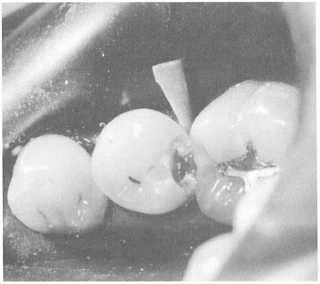
Figure 5-6. - Interproximal caries.
dental caries or fractured teeth. Pulpitis may be caused by other conditions, such as chemical irritants and thermal changes with materials used in dental restorations that can transmit heat or cold to the dental pulp. When micro-organisms enter the pulp, they start to produce severe damage, which leads to a buildup of pressure in the canal. The result of this pressure may cause a dull ache that can lead to a more severe, pulsating pain. When severe pulpitis occurs, the dentist may remove a portion or all of the pulp in an injured tooth.
PERIAPICAL ABSCESS
A periapical abscess results when the pulp has become inflamed and a small pus-like abscess forms in the pulpal canal. If left untreated, the inflammation spreads out through the apex of the root and into the bone. As the abscess gets bigger, pressure from the inflammation and pus at the apex of the root may cause the tooth to be pushed up higher in its socket. The patient may complain the tooth feels "high" when biting and very sensitive to touch.
Bone loss around the apex of the tooth can occur if left untreated. The abscess and bone loss at the apex cause a radiolucency appearing like a "grape" when viewed radiographically. The course that the abscess of pus follows from the apex, into the jaw bone, and drains into the mouth is referred to as a fistula
NECROSIS
The death of tissue is called necrosis. Pulpal necrosis can occur as a result of untreated pulpitis or from a traumatic injury. A tooth that is necrotic must be treated. The dead pulpal tissue will decompose, producing toxins that will smell foul or rotten when the tooth is being treated. Dental pain may or may not occur from a necrosis.
PATHOLOGY OF THE PERIODONTIUM
Periodontal disease is the most prevalent chronic disease of mankind. The term periodontal disease refers to all diseases of the periodontium and can affect the tissues around and supporting the teeth. As a basic dental assistant, you should know symptoms of periodontal disease your patients might describe:
Bleeding gingival tissue during toothbrushing
Tender or red swollen gums
Receeding gingival tissue
Tooth shifting or elongation (looks longer)
Mobile (loose) teeth
Purulent exudate (pus) in-between the teeth and gums
Abnormal change in the fit of partial dentures
Halitosis (bad breath)
GINGIVITIS
Gingivitis is an inflammation involving the gingival tissues. Conditions pertaining to the gingiva of principal concern to the Dental Assistant are marginal gingivitis and acute necrotizing ulcerative gingivitis. 5-6
